Michael created 10x more debris than Irma
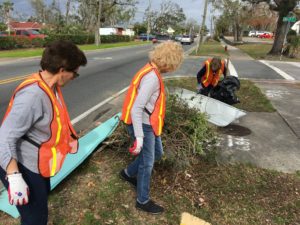
Lisa Miller with LMA volunteers cleaning-up debris in Panama City, FL, January 12, 2019
Our volunteer crew from Lisa Miller & Associates helped clean-up a Panama City neighborhood last weekend. We saw what Governor DeSantis saw a few days later when he visited and then ordered the state to speed up recovery money to affected communities: debris, debris, and more debris.
Our crew of folks from Tallahassee, Pensacola, and Georgia collected tree and trash debris in two neighborhoods off of West Beach Drive just outside downtown. We also manned the brooms and gave the sidewalks a good sweeping. Despite the seriously damaged homes and endless piles of debris we saw, there is something uplifting to at least having a clean sidewalk – a small but significant sign of normalcy in a town that three months post-Hurricane Michael is anything but normal. Several residents stopped to thank us for remembering them and pitching-in to what was part of a city-wide cleanup day.
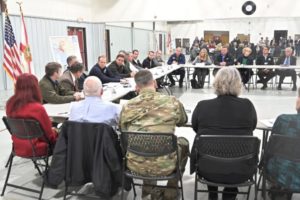
Governor DeSantis at Hurricane Michael recovery briefing with FEMA & local officials in Panama City, FL, January 16, 2019
The Governor visited Panama City and nearby towns this past week – his second since taking office – and met with FEMA Director Brock Long and local officials to assess the progress. He later ordered the state Department of Emergency Management to expedite more funds to local communities so they can get 50% of the costs upfront to help accelerate what he called the “massive” debris cleanup. He is also asking the White House to increase federal reimbursement to local communities, who simply don’t have the budgets to fund the cleanup upfront.
The state is providing $2.8 million in matching funds for debris removal in Mexico Beach, ground zero for the high-end Category 4 storm that struck with devastating 155 mph winds and 15 foot storm surge. The usual reimbursement process is slow and cumbersome. Last week, Senator Bill Montford (D-Tallahassee) whose district includes some of the worst hit areas, filed SB 376 that would allot up to $50 million a year from the state Land Acquisition Trust Fund for the 14 counties that suffered damage. The trust is funded by doc stamp taxes for land and water conservation and last year brought in $870 million. Another bill, HB 191 would pull $100 million from the BP Oil Spill Deep Horizon fund for inland counties (more in Bill Watch).
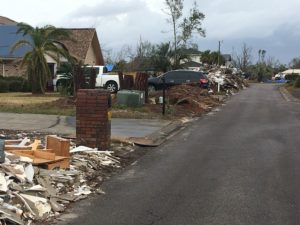
Piles of debris sit outside each house in the Derby Woods subdivision in Lynn Haven, FL, January 12, 2019
FEMA Director Long said more trailers are on their way to the Panhandle to provide temporary housing to displaced residents. He noted that “large-scale disaster recovery takes many years, not months” and that the area has a long way to go. Director Long said he doesn’t expect the response will be impacted by the current federal shutdown.
Estimates are that Hurricane Michael created 20 million cubic tons of debris as it cut a 60-mile wide path from the Gulf of Mexico into Georgia. Compare that to the 2 million cubic tons of debris created by Hurricane Irma, which cut a swath from Key West to Jacksonville in September 2017. While local governments, years later, usually end up being reimbursed 75% by the feds for debris removal, the Governor is pushing for 90% for Michael. Until the debris is removed, business and tourism can’t fully return.
More than $835 million in federal funds has been provided for homeowners, renters, businesses and federal flood insurance policyholders as of Jan. 9. There’s a full breakdown here. As of January 11, 141,039 Florida claims with estimated insured losses now topping $5 billion have been filed. Nearly 73% of those claims are closed (of those, 84% were paid and 16% unpaid which has remained a steady stat). Georgia reports $1.1 billion in losses from 95,182 claims as of January 3.
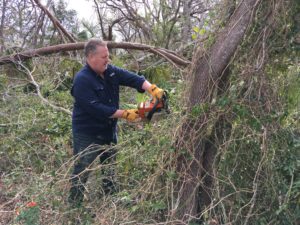
LMA Volunteer Mike Rogers cutting away damaged branches in Panama City, FL, January 12, 2019
State Senator Doug Broxson (R-Gulf Breeze), Chairman of the Senate Banking & Insurance Committee, said he believes Michael will turn out to be a $10-billion storm. He continues to lead and push for help in the panhandle, especially from the federal government, saying in a recent article that “it’s the most uninsured storm ever to hit Florida. We’ve got more than $2 billion of timber that’s been destroyed. Those are generational problems. They’re not five-year fixes. They’re 30-year fixes.” Panhandle residents are lucky to have Sen. Broxson as a champion.
Meanwhile, the trade group Restoration Association of Florida, was having a meeting of its own this past week, with members of the public invited, but not insurance companies. There were complaints of slow-paying and underpaying claims. But as we know, carriers are working diligently at processing claims that take time and sometimes change – and so do the claims payment as new damage is discovered.
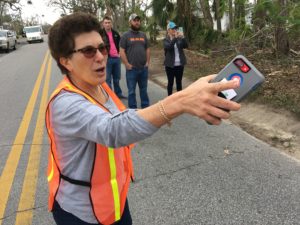
Lisa Miller & team directing a front loader removing debris in Panama City, FL, January 12, 2019
Chris Davis, manager of Noble Public Adjusting Group and who has appeared on a local TV series “Insurance Wars” distributed on Facebook, sums it up this way in the local newspaper: “The original idea behind the show was education. If you go down to Miami, they don’t even call their insurance company when they have a claim to file. They call a PA or attorney and the PA or attorney files a claim for them,” Davis said. “They’ve been hit so many times with storms they know the hustle before the game begins. That’s not the case in the Panhandle of Florida. It doesn’t get hit that often.”
Really Chris? Since the insurance industry started over 200 years ago, policyholders called their insurance company first with a claim. There’s only one reason to call someone OTHER than the insurance company first and that’s the greed behind the PA or attorney who doesn’t suggest to their client to work it out BEFORE seeking outside assistance.
Readers of this LMA Newsletter were reminded as recently as the last edition, in a carrier litigation chart provided by Citizens Property Insurance, that only 1 in 4 lawsuits originate from an assignment of benefits document. That means that unfortunately, Chris Davis’ discussion above is true because, as noted earlier, greed is driving the lawsuit explosion. It is NOT in the best interest of policyholders to call anyone other than the insurance company first, but the increasing billboards and advertising by lawyers, incorrectly, say otherwise.

